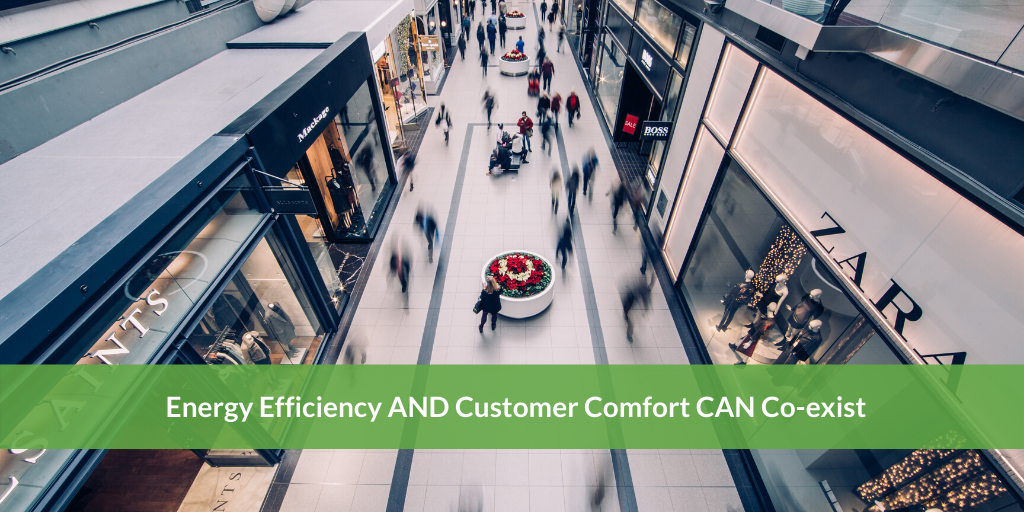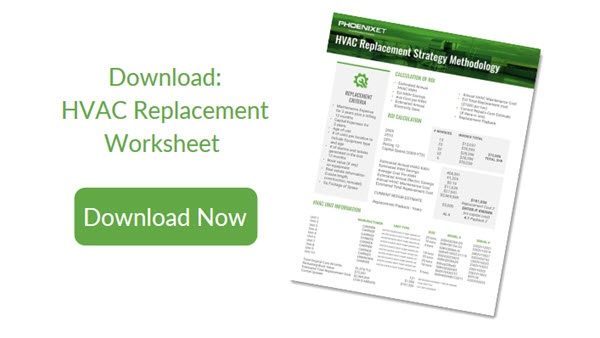Share this
Energy Efficiency AND Customer Comfort CAN Co-exist
by Phoenix Energy Technologies on Jul 20, 2020

Building and energy managers sometimes focus on energy-saving strategies to the point that occupants' comfort is sacrificed. But through careful planning and the right tools, building operators can achieve energy benchmarking goals and still keep customers, employees, and other occupants safe and comfortable.
Energy Savings and Occupant Comfort
To address the issue of energy savings versus comfort, we must first understand how the two variables are correlated. This has been established with the Acceptability Index Value (AIV) or the Energy Utilization Index (EUI) ratio, which measures energy usage per the square footage of a building. The EUI is used to "evaluate the effectiveness of energy use to achieve a specified percentage of occupant acceptability."
These metrics are broken down into specific variables and include:
- Electrical power
- Lighting
- Heating
- Cooling
- Moisture control
- Acoustics
- Ingress and egress control
With this data, energy usage can be adjusted to the correct parameters to meet quality comfort levels.
Building Automation Systems and Occupant Comfort
Energy Management Systems (EMS) allow building operators to view energy consumption and look for cost savings opportunities, however, they don’t consider how these strategies might affect building comfort. When coupled with Building Automation Systems (BAS), managers can fine-tune these strategies while maintaining healthy, comfortable environments that help the building’s occupants do their best work.
To do this requires installing controls on HVAC and lighting systems so they can be both manipulated remotely and return system information vital to energy savings and comfort. For example, a cycling fan on an RTU can be seen on a BAS if the temperature is not meeting the space setpoints. With this level of information, a building operator can repair the unit, saving energy when the unit is operating at its optimized state and providing better cooling at lower energy consumption.
LEARN HOW: Optimizing buildings for COVID to Increase Comfort & Safety

Strategies for Comfort Focused Energy Efficiency in Buildings
Energy efficiency contributes to optimal occupant health and comfort with the right strategies and tools in place. With a whole-building approach, design can bring elements such as natural daylighting and LED lights that not only reduce energy costs but improve occupant comfort. You may also consider some of the following:
- Building Commissioning - Energy-efficient whole-building design is essential to reducing energy costs. But implementing energy-saving strategies as the design intended is building commissioning - testing building systems to verify they meet design conditions. Commissioning provides value by adjusting and fine-tuning HVAC and lighting systems to result in optimal energy savings and occupant comfort.
- High-Efficiency Lighting and Control Systems - LED lighting is becoming standard in commercial buildings and can drastically reduce energy costs. It also produces less heat than fluorescent light, keeping the temperature down in brightly lit spaces.
- Individual occupant controls - Two people can be sitting in the same room, and one of them is too hot, the other too cold. When it comes to optimal temperature controls within a few degrees, comfort levels can be subjective. Individual space controls can mitigate the issue. When spaces are unoccupied, sensors can set individual space temperatures up or down and turn off lighting to reduce costs.
Understanding Today's EEM Solutions
Whole Building Efficiency and Well Being
A healthy building is an efficient building. By considering the effects of energy-saving methods on occupants and adjusting to meet their needs, a building can achieve its desired intent and long term operational goals. An analysis of HVAC systems and controls, lighting systems and controls, building orientation, views and daylighting, and overall aesthetic can all play a role and must be considered by building operators. With systems and protocols in place, efficiency and comfort can both be achieved. 
Additional Resources
Energy Management for Grocery Stores
Adaptive Energy Management Guide
Guide to Building Management Technology
Share this
- Facilities Management (91)
- Energy Management (69)
- Company News (49)
- Smart Buildings (37)
- Retail (36)
- Building Management (24)
- Building Automation Systems (21)
- Sustainability (20)
- Energy Demand Management (19)
- EEI (15)
- Adaptive Energy Management (14)
- Grocery (14)
- demand response (14)
- Artificial Intelligence (12)
- Data Integration and Visibility (10)
- HVAC IQ (9)
- COVID-19 (8)
- Customer Spotlight (8)
- Carbon Management (7)
- Setpoints and Temperatures (7)
- Equipment Maintenance (6)
- Operational Efficiency (6)
- Refrigeration Optimization (6)
- Ask Ron (5)
- Asset Manager (5)
- Finance and Procurement (5)
- IoT and Digital Transformation (5)
- Awards (4)
- Comfort (4)
- Energy & Store Development (4)
- Safety and Compliance (4)
- Demand Charge Management (3)
- Energy Management System (3)
- Lifecycle Asset Management (3)
- Premium Services (3)
- Refrigeration IQ (3)
- Automated Demand Response (2)
- ConnexFM (2)
- Customer Service (2)
- HVAC Vendor Management (2)
- Load Shedding (2)
- Technician View (2)
- AIM Act (1)
- ALD (1)
- Analytics (1)
- Data (1)
- Data Integration and Visualization (1)
- EMS (1)
- Knowledge Center (1)
- OSHA (1)
- asset management (1)
- December 2025 (1)
- November 2025 (1)
- October 2025 (2)
- September 2025 (1)
- August 2025 (3)
- July 2025 (1)
- June 2025 (1)
- May 2025 (2)
- March 2025 (2)
- February 2025 (1)
- January 2025 (2)
- December 2024 (2)
- October 2024 (1)
- September 2024 (1)
- August 2024 (2)
- June 2024 (2)
- April 2024 (2)
- March 2024 (2)
- January 2024 (1)
- December 2023 (1)
- October 2023 (2)
- September 2023 (2)
- August 2023 (2)
- July 2023 (1)
- May 2023 (2)
- April 2023 (2)
- March 2023 (3)
- February 2023 (1)
- January 2023 (1)
- December 2022 (1)
- November 2022 (2)
- October 2022 (2)
- September 2022 (1)
- May 2022 (2)
- April 2022 (1)
- March 2022 (3)
- February 2022 (2)
- January 2022 (4)
- December 2021 (2)
- November 2021 (3)
- October 2021 (1)
- September 2021 (3)
- August 2021 (4)
- July 2021 (1)
- June 2021 (2)
- May 2021 (1)
- January 2021 (2)
- December 2020 (2)
- November 2020 (2)
- October 2020 (3)
- September 2020 (4)
- August 2020 (3)
- July 2020 (2)
- June 2020 (3)
- May 2020 (3)
- April 2020 (5)
- March 2020 (5)
- February 2020 (4)
- January 2020 (4)
- December 2019 (4)
- November 2019 (3)
- October 2019 (4)
- September 2019 (5)
- August 2019 (4)
- July 2019 (4)
- May 2019 (2)
- April 2019 (3)
- February 2019 (1)
- December 2018 (1)
- November 2018 (1)
- October 2018 (3)
- September 2018 (3)
- August 2018 (3)
- July 2018 (3)
- June 2018 (3)
- May 2018 (1)
- June 2015 (1)
- March 2013 (1)
- January 2013 (1)
- December 2011 (1)
- October 2011 (1)
- September 2011 (1)


